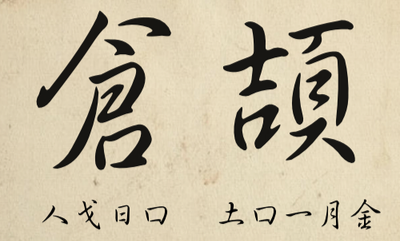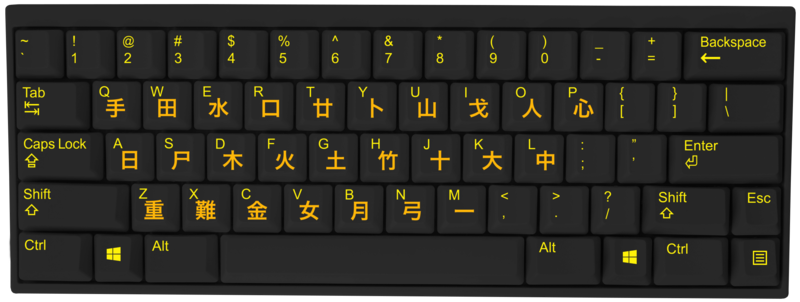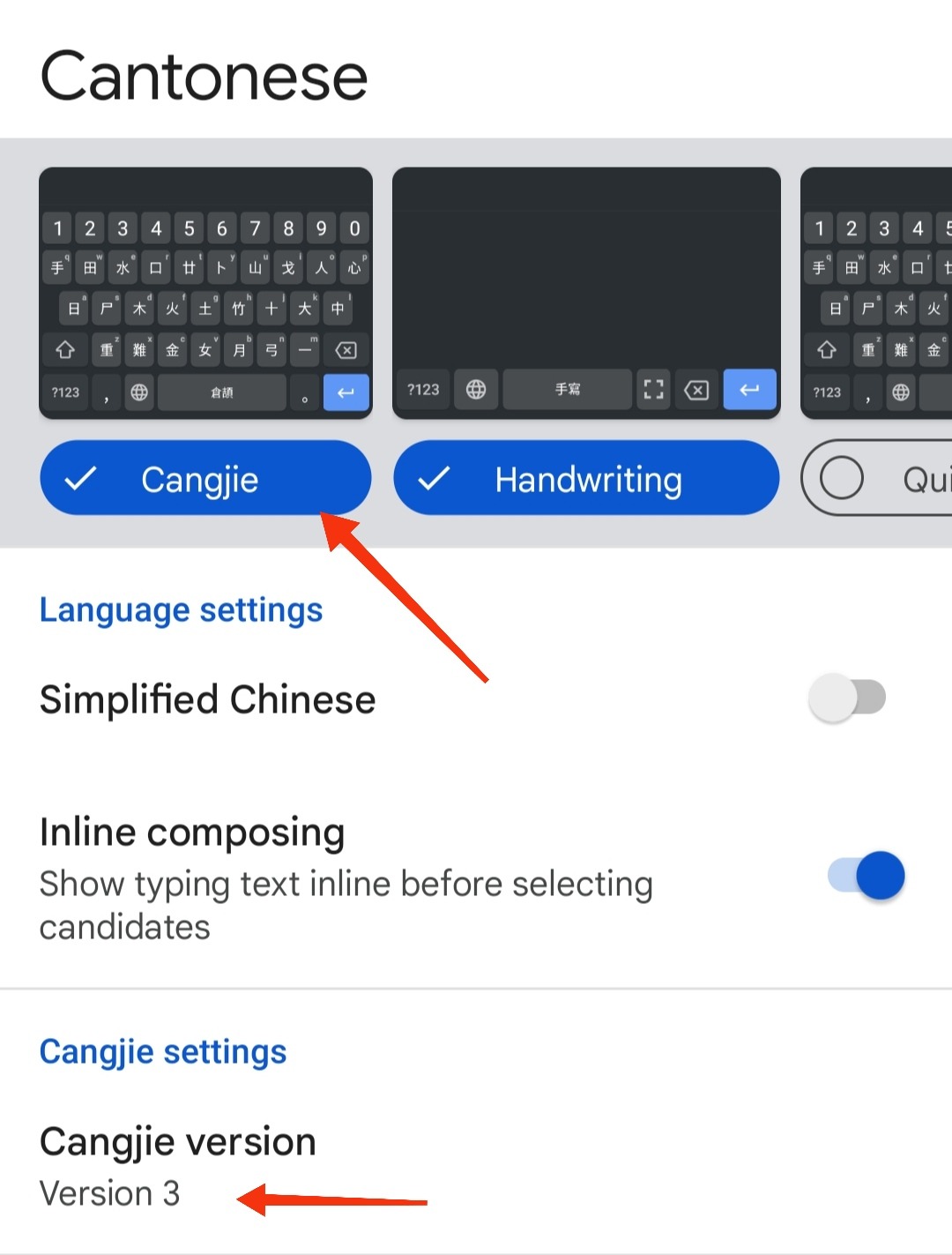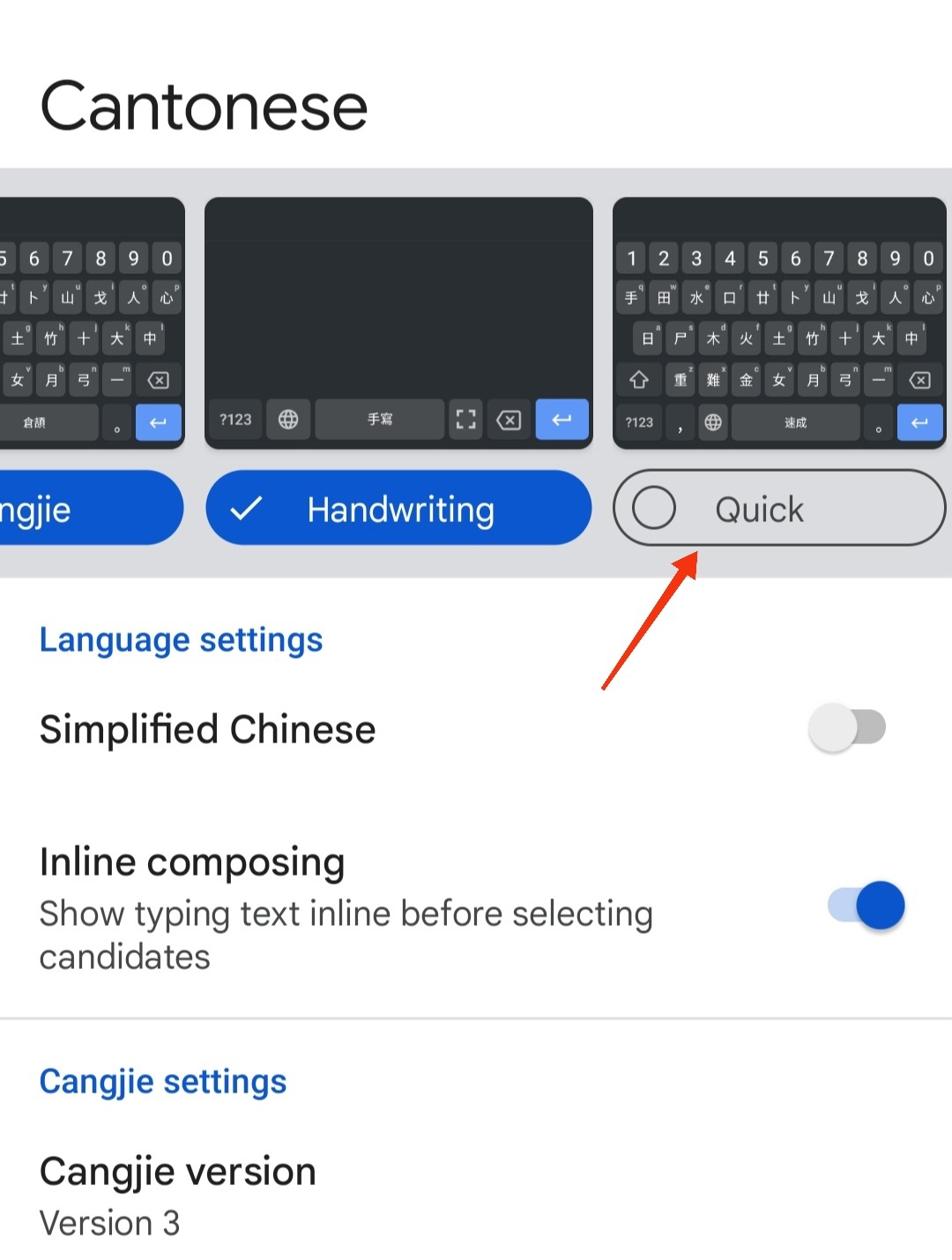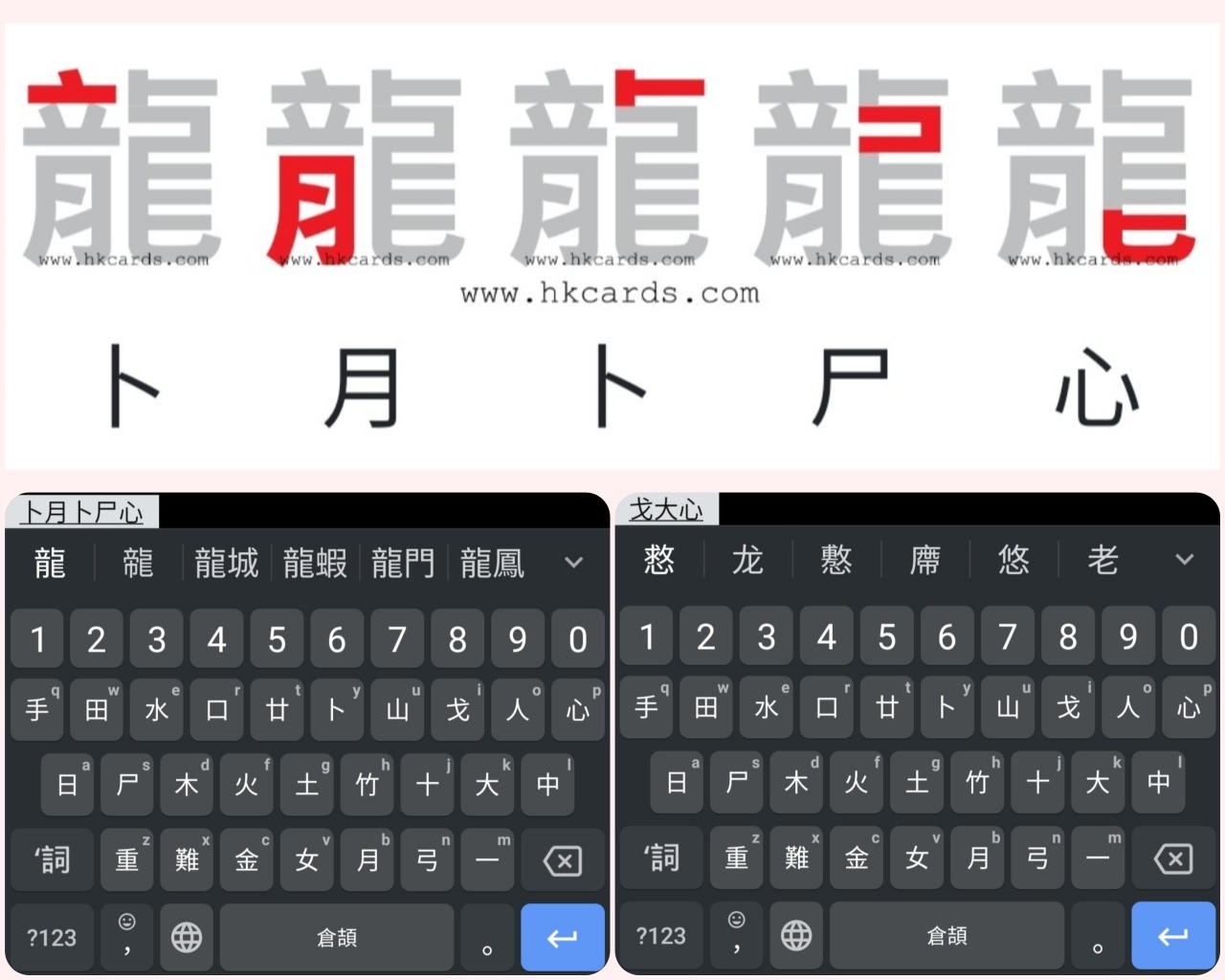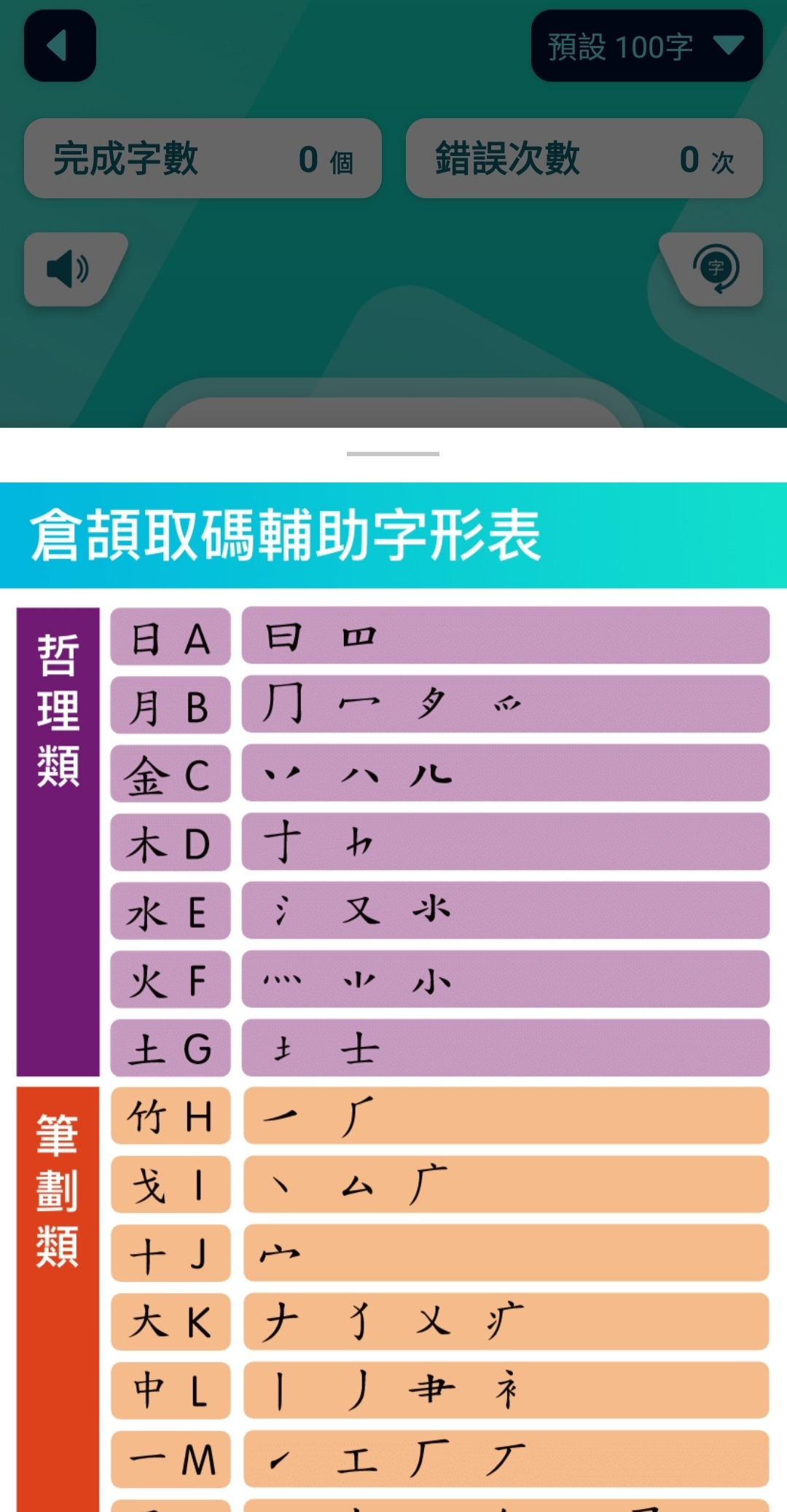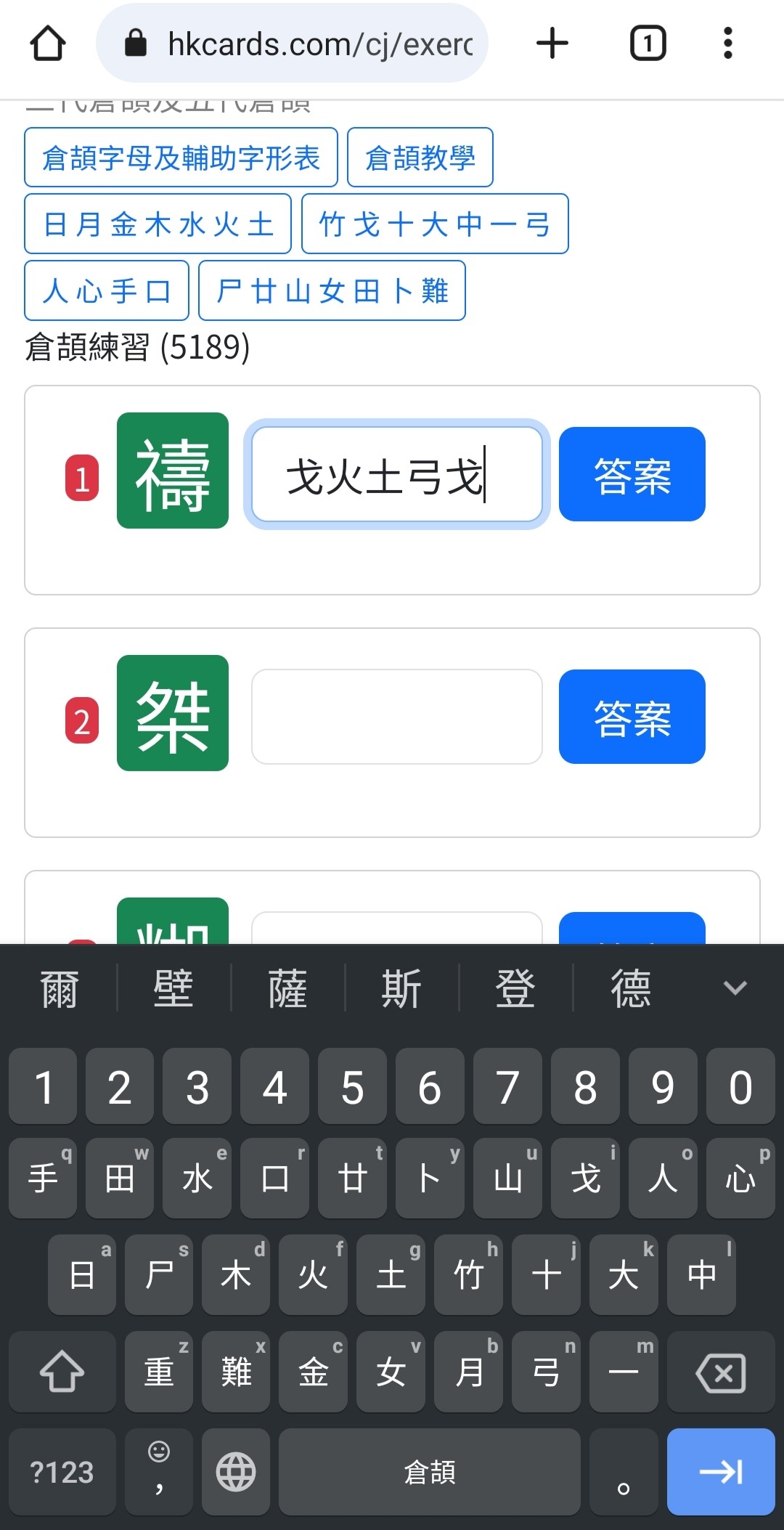So I’ve been playing around with Cāngjié…
And I thought a post like this (similar to a post on Zhùyīn done by linghxr) may be of interest to some.
Edited: 10 Sep 2023
This post has gotten a little popular lately and on scrutinizing my own post again, I’ve come to the conclusion that I had made some mistakes in my given character examples.
Amended now. Namely, 「唔」 and 「龍」 have now been swapped over in the examples.
「唔」 is really the “3-parts”, and 「龍」 is indeed a “2-parts” character! Amendments are reflected in orange.
What (and who) is Cāngjié?
For those who may not know, Cāngjié is another way to input 漢字/汉字 (Hànzì — Chinese characters). It is way less popular than Pinyin (or even Zhuyin) but it still has its fans, and has a few advantages over the other two.
Cāngjié is also the name of the mythical figure in Chinese legend who is said to have been the inventor of 漢字/汉字, for which Cāngjié (the input system) was named after.
Would I recommend it?
Yes, if you think you have already acquired a good (enough) understanding of 漢字/汉字, and/or just like a new challenge.
(TL;DR at the end)
Why am I learning Cāngjié (and why you may like to, too)?
1. Mostly for fun.
Have long been intrigued by both Cāngjié and Zhùyīn, and since I finally mustered up the courage to tackle Zhùyīn not too long ago, I thought I’d finally give Cāngjié a try.
While learning Cāngjié does require more effort than learning Pinyin or Zhuyin, it can also be really fun!Inputting 漢字/汉字 with the Cāngjié method is almost like doing a jigsaw puzzle.
The euphoria derived from figuring out and piecing together the radicals that make up a word is something that learning Jyutping (Cantonese equivalent of Pinyin), Pinyin or Zhuyin can’t quite match.
And while I know I’ll never be as adept with Cāngjié — my knowledge of 漢字/汉字 is nowhere near good enough to ever use Cāngjié efficiently — as I do Jyutping or Pinyin (or to some extent, Zhuyin), it’ll still be fun to use Cāngjié every once in a while!
2. Helps with thinking and typing in Chinese.
The upshot of relying too much on using Jyutping/Pinyin/Zhuyin is, I’d tend to think in Roman letters or ㄅㄆㄇㄈ before I’d even think about the actual 漢字/汉字.
But with Cāngjié, because it’s based on knowing radicals and joining them together to form actual characters, it’ll encourage thinking of 漢字/汉字 first, so I think that would help some with 漢字/汉字 memory retention.
Now you may be thinking, why not just you know, practise actually writing then? That is the tried and proven method to better remember 漢字/汉字 after all?
Yes, of course I can do that — and am doing so occasionally — but we live in a digital age now, and the probability and opportunity to type things out is much higher than actually writing stuff by hand.
The idea here is, more looking to think of and envision characters fully in my head, and trying to lessen over-reliance on Jyutping/Pinyin/Zhuyin.
And this is where I find Cāngjié can be useful, which leads to my next point…
3. Haunted by “What if” scenario.
What if there comes a day (however improbable) where I’m presented with only a Cāngjié keyboard to use for typing Chinese?It has happened with Zhùyīn for me!
That means, no Pinyin or Zhuyin keyboards, no Handwriting tools/touchscreens to write with fingers/mouse, no speech-to-text, and no option to copy-and-paste characters from somewhere else either! What then?
4. Able to type without knowing pronunciation, and with more accuracy.
Cāngjié is shape-based. Unlike Jyutping/Pinyin/Zhuyin, where you have to know what a character sounds like before you can type it out, with Cāngjié, you can type out (again assuming no Handwriting or other tools available) characters without needing to know how to pronounce them at all.
With shape-based typing, you’d also get more accurate hits in the first few 漢字/汉字 that show up, versus sound-based methods like Pinyin where for e.g., typing out “wan” will get you a whole list under the same sound and you may have to scroll through a whole lot to get the exact “wan” you need.
You can also type both Traditional and Simplified characters without having to toggle something or switch keyboards.
So how does one begin learning Cāngjié?
Install a Cāngjié keyboard.
Duh…but of course! Heh! Gboard offers one, banded under Cantonese language input (Android user here, don’t know about iPhones, sorry).
There are two versions of Cāngjié that are prevalent currently. Cāngjié 3 and Cāngjié 5. Cāngjié 5 is supposed to be an improvement over version 3 but I don’t find there’s much; having a slightly altered version just adds to the confusion and unnecessarily complicates matters, in fact!
If you have a choice, I’d recommend selecting Cāngjié 3 as that is more supported. Some operating systems may not be too compatible with Cāngjié 5 still, for some strange reason.
You may also come across something called “Quick” (速成) aka, “Simplified Cāngjié”.
This is simply a scaled down version of Cāngjié, it’s still based on Cāngjié’s formula. So you still need to know how Cāngjié works in order to use “Quick” efficiently.
You’d then need a chart like this. ↓
* the 重 (Z) key doesn’t really come into use. I don’t really know what it’s for, but it seems to be used (paired with other keystrokes) mainly to type out various punctuation marks.
There are variants out there, some having a little more, or less, radicals shown than in the above example, but I’ll say the chart here is one of the more comprehensive ones I’ve found so far (and sufficient enough) — other charts often fail to highlight the 難 (X) key and what it corresponds to.
You don’t have to memorize the chart all at once. Just always have a chart like this on hand to refer to and with enough typing practise, you’ll eventually remember which key corresponds with which radicals.
Remember the rules. ↓
- “1 part” character (e.g. 寫) = first 3 & last (radical).
- “2 parts” character (e.g.
唔龍) = first & last, first 2 & last. - “3 parts” character (e.g. 難) = first & last, first & last, last.
e.g. 寫 ↓
With radicals 宀,丿,臼 (first 3) and 灬 (last).
Corresponding keys: 十,竹,難 and 火。
寫 → 写 ↓
With radicals 冖,卜,㇆ (first 3),一 (last).
Corresponding keys:月,卜,尸 and 一。
e.g. 龍 ↓
With radicals 亠,月 (first & last), 卜,コ (first 2),ヒ (last).
Corresponding keys: 卜,月,卜,尸,and 心。
龍 → 龙 ↓ (Simplified 龍 → 龙,a “1 part” character)
With radicals 丶,ナ,ヒ (first 3).
Corresponding keys: 戈,大,and 心。
e.g. 難 ↓
With radicals 廿,人 (first & last),亻(first & last),土 (last).
Corresponding keys: 廿,人,人 and 土。
難 → 难 ↓
With radicals ヌ (first & last),亻(first & last),土 (last).
Corresponding keys: 水,人,and 土。
Occasionally, you may get a character that looks like a “2 parts” but is actually a “3 parts”. ↓
e.g. 唔 ↓
With radicals 口 (first & last),一,一 (first & last),口 (last).
Corresponding keys: 口,一,一 and 口。
Or looks like a “1 part” but really a “3 parts”. ↓
e.g. 奪 ↓
With radicals 大 (first & last),亻,土 (first & last),丶 (last).
Corresponding keys: 大,人,土,and 戈。
奪 → 夺 ↓(Simplified 奪 → 夺,a “1 part” character)
With radicals 大,寸 (first 3; the 丶 is the 3rd component).
Corresponding keys: 大,木,and 戈。
But these are exceptions, and don’t occur that often.
And you can start practising!
You can try out this pretty good app called 『五色學倉頡』 (learning Cāngjié with 5 colours), for practise. It’s on Playstore, just search for “Cangjie Dictionary” and it should show up.
You have to pay to unlock higher levels, unfortunately. ↓
Anyway, each character comes with colour coded hints and you can opt to turn them off if you like more of a challenge. There are also hints (提示) and the chart (字根表) to refer to if you’re really stuck. Also has a dictionary component (查字典) to check out the Cāngjié input for characters.
Another option would be a website called HKCards. ↓
You can use it to check the Cāngjié input for any 漢字/汉字, and there’s section for practise (倉頡輸入法練習) as well. After inputting your answer with Cāngjié keys (手田水口廿卜), you can click on the “Answer” (答案) button to see how right or wrong your answers were. ↓
There are 8 characters each time, and you can just hit “Practise Again” (再做練習) to refresh for another 8 to practise with. I’ve yet to hit a limit.
Unfortunately, this website has lots of ads popping up. And it only supports searching in Traditional characters (Cāngjié was initially catered more for Traditional).
Or you can just try practising randomly with a Cāngjié keyboard and check for mistakes with a Cāngjié dictionary (『五色學倉頡』 app’s dictionary comes in really useful here — it appears to support searching in Simplified too).
TL;DR
Cāngjié could be useful (and fun) to know if your 漢字/汉字 knowledge is already adequate, and/or you just like a new challenge.
And if watching videos is more your thing, here’s a really helpful YouTube tutorial on how to use Cāngjié (has English subs)!
 thaeon liked this
thaeon liked this thepurpleether reblogged this from don-dake
thepurpleether liked this
 tajnyagentpaula123-blog liked this
tajnyagentpaula123-blog liked this rvfvellv liked this
juicebug reblogged this from chinese-maiior
 blightandfire liked this
blightandfire liked this  theawkwardadult50 reblogged this from don-dake
theawkwardadult50 reblogged this from don-dake  theawkwardadult50 liked this
theawkwardadult50 liked this  kunagisana reblogged this from don-dake
kunagisana reblogged this from don-dake hellphrog liked this
breivete reblogged this from don-dake and added:
Holy shit, this is a game changer
breivete liked this
milkywilkysdreams liked this
languorastra reblogged this from fouryearsofshades
lilykitai liked this
thatficwheretheprotagisadog liked this
 romantickowloon reblogged this from don-dake
romantickowloon reblogged this from don-dake  romantickowloon liked this
romantickowloon liked this  candidaa liked this
candidaa liked this hiddenmagenta reblogged this from bngrc
letmerocktheparty liked this
knotfaries reblogged this from don-dake
theterrorofthedeep liked this
leilanguageblr reblogged this from don-dake
iamarandomeegplant liked this
 ydrance liked this
ydrance liked this yakultliver liked this
 thewhitecyborg liked this
thewhitecyborg liked this  aimlessartist17 reblogged this from don-dake
aimlessartist17 reblogged this from don-dake jujube liked this
 anonymousbobert liked this
anonymousbobert liked this aeschylus03 reblogged this from fouryearsofshades
aeschylus03 liked this
tyelkormo liked this
 digitalcactusblog liked this
digitalcactusblog liked this phlebasphoenician liked this
everythingispickles liked this
 minjad liked this
minjad liked this  misskanda reblogged this from fouryearsofshades
misskanda reblogged this from fouryearsofshades mim8icri liked this
 misskanda liked this
misskanda liked this kcrabbz reblogged this from fouryearsofshades
kcrabbz liked this
iceaquasoul liked this
mysteriouslypleasantcat reblogged this from fouryearsofshades
mysteriouslypleasantcat liked this
don-dake posted this
And I thought a post like this (similar to a post on Zhùyīn done by linghxr) may be of interest to some.
- Show more notes
